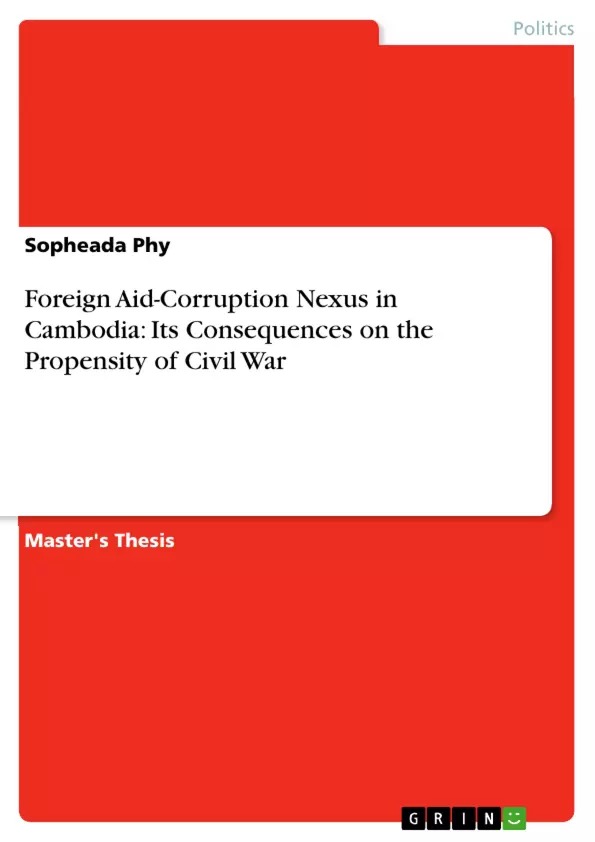Contemporary Cambodia is most likely best known for two things, aid dependency and corruption. The thesis initially seeks to examine the nexus between foreign aid and corruption in Cambodia since 1993, the time when a huge influx of foreign aid injected into the country following the withdrawal of UNTAC, then explores if the correlation of the two encourages the propensity of civil war, and ultimately analyzes if the onset of civil war is attainable in the case that the propensity of civil war is feasible. Drawing from the analysis, the thesis concludes that “Foreign aid, particularly loans, indirectly instigates civil war by partly generating corruption, particularly political corruption, because corruption makes aid ineffective in contributing to economic growth and poverty reduction, while encourages huge economic inequality and chronic poverty, which makes Cambodia more vulnerable and prone to civil war”. However, the civil war in Cambodia is manifested or not depends on the motivation and initiative to be resisted and the means of financing the resistant group. Given the status quo of Cambodia, it is possible that the prominent opposition groups such as the opposition political parties can initiate the resistant
movement; but it seems improbable. Concerning the ways of financing the rebel movement, by applying the Collier and Hoeffler Model of Civil War, although the opportunity of recruiting the members of the rebel group, the given natural geography, and the cohesion of the movement seems merely attainable, the way of financing the rebellion, through three fundamental means—extortion from the primary commodities-natural resources, donation from diaspora, and subvention from hostile governments—is unlikely feasible. If motivation and finance were not achievable, the rebel movement could not even be formed. However, sometimes unpredictable things might happen.
Inhaltsverzeichnis (Table of Contents)
- CHAPTER I: Introduction
- 1. Background, Rationale, and Objectives
- 2. Structure of the Thesis
- CHAPTER II: Research Methodology, Literature Review, and Conceptual Discussion
- 1. Research Methodology
- 1.1 Data Collection Method
- 1.2 Data Analysis Method
- 2. Literature Review
- 3. Conceptual Discussion
- 3.1 Foreign Aid
- 3.2 Corruption
- CHAPTER III: Foreign Aid and Corruption in Cambodia
- 1. The Overview of Historical Context and Foreign Aid Trends in Cambodia
- 2. The Political Economy of Foreign Aid and Corruption in Cambodia
- CHAPTER IV: Foreign Aid, Corruption, and the Propensity of Civil War in Cambodia
- 1. Foreign Aid and Corruption in Cambodia: Creating Conditions for Civil War?
- 2. Greed versus Grievance Theory of Civil War: How Does the Case of Cambodia Fit?
- 2.1. Extortion of Primary Commodity-Natural Resources
- 2.2. Donation from Diaspora
- 2.3. Subvention from Hostile Governments
Zielsetzung und Themenschwerpunkte (Objectives and Key Themes)
This thesis examines the complex relationship between foreign aid and corruption in Cambodia since 1993, focusing on the potential link to the propensity of civil war. The study explores whether the interplay of these factors can contribute to a heightened risk of conflict in the country.
- Foreign aid and corruption nexus in Cambodia
- Influence of foreign aid on economic growth and poverty reduction
- Role of corruption in exacerbating economic inequality and poverty
- Link between corruption and the propensity of civil war
- Analysis of factors influencing the feasibility of civil war initiation in Cambodia
Zusammenfassung der Kapitel (Chapter Summaries)
Chapter I introduces the research topic, providing background information on Cambodia’s post-conflict context, rationale for the study, and the specific objectives. It also outlines the structure of the thesis.
Chapter II details the research methodology employed in the study, including data collection and analysis methods. It further explores the literature on foreign aid, corruption, and civil war, followed by a conceptual discussion on the key terms—foreign aid and corruption—in the context of Cambodia.
Chapter III examines the historical context of foreign aid in Cambodia since 1993, analyzing the trends and patterns of aid provision. It then delves into the political economy of foreign aid and corruption in the country, highlighting the complex interplay between these factors.
Chapter IV investigates the potential link between foreign aid, corruption, and the propensity of civil war in Cambodia. It explores the conditions created by foreign aid and corruption that might contribute to civil war, and examines the "greed versus grievance" theory of civil war in the context of Cambodia. This chapter also analyzes various financing mechanisms that could potentially fuel a rebel movement, including extortion, donations from diaspora, and subventions from hostile governments.
Schlüsselwörter (Keywords)
The key terms and concepts that underpin this thesis include foreign aid, corruption, civil war, economic growth, poverty reduction, economic inequality, political corruption, and the "greed versus grievance" theory of civil war. The study primarily focuses on the case of Cambodia, exploring the specific context of foreign aid dependency and corruption, their impact on socio-economic conditions, and their potential contribution to the propensity of civil war.
- Quote paper
- Sopheada Phy (Author), 2009, Foreign Aid-Corruption Nexus in Cambodia: Its Consequences on the Propensity of Civil War, Munich, GRIN Verlag, https://www.hausarbeiten.de/document/143264


